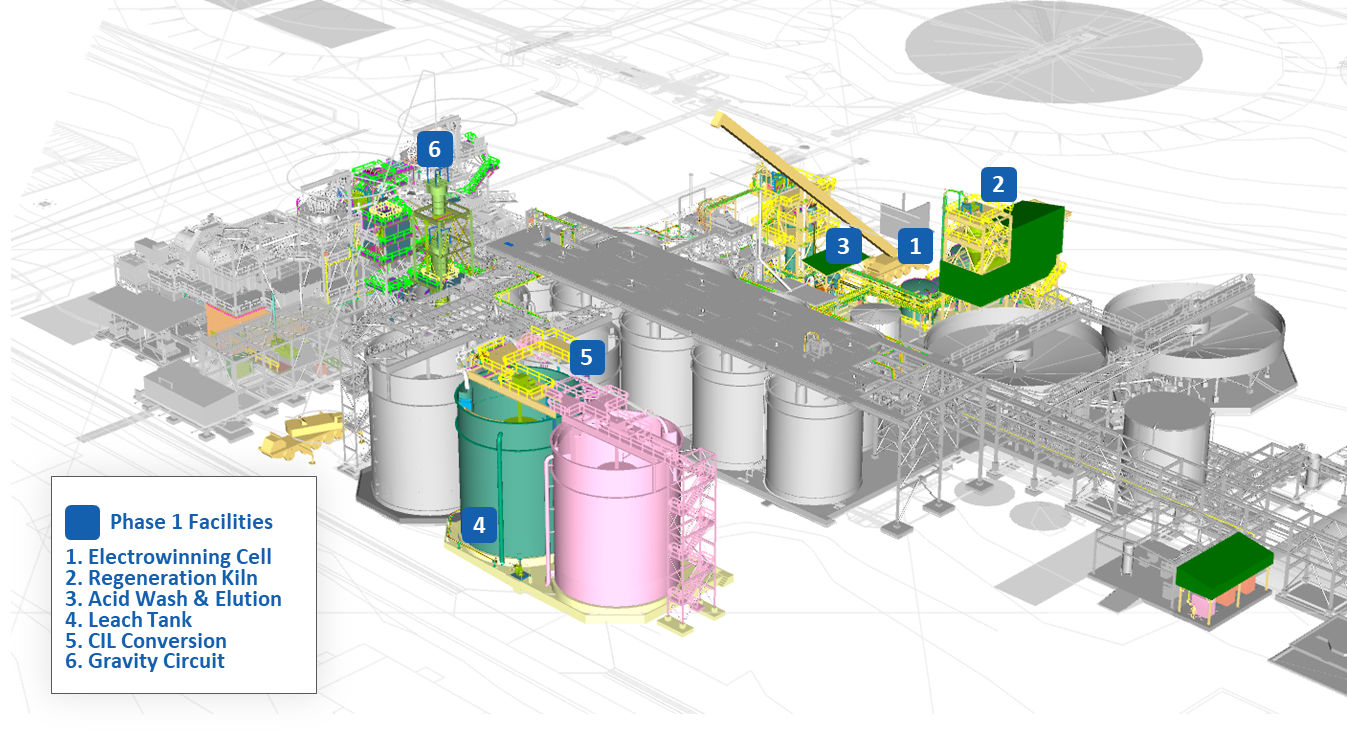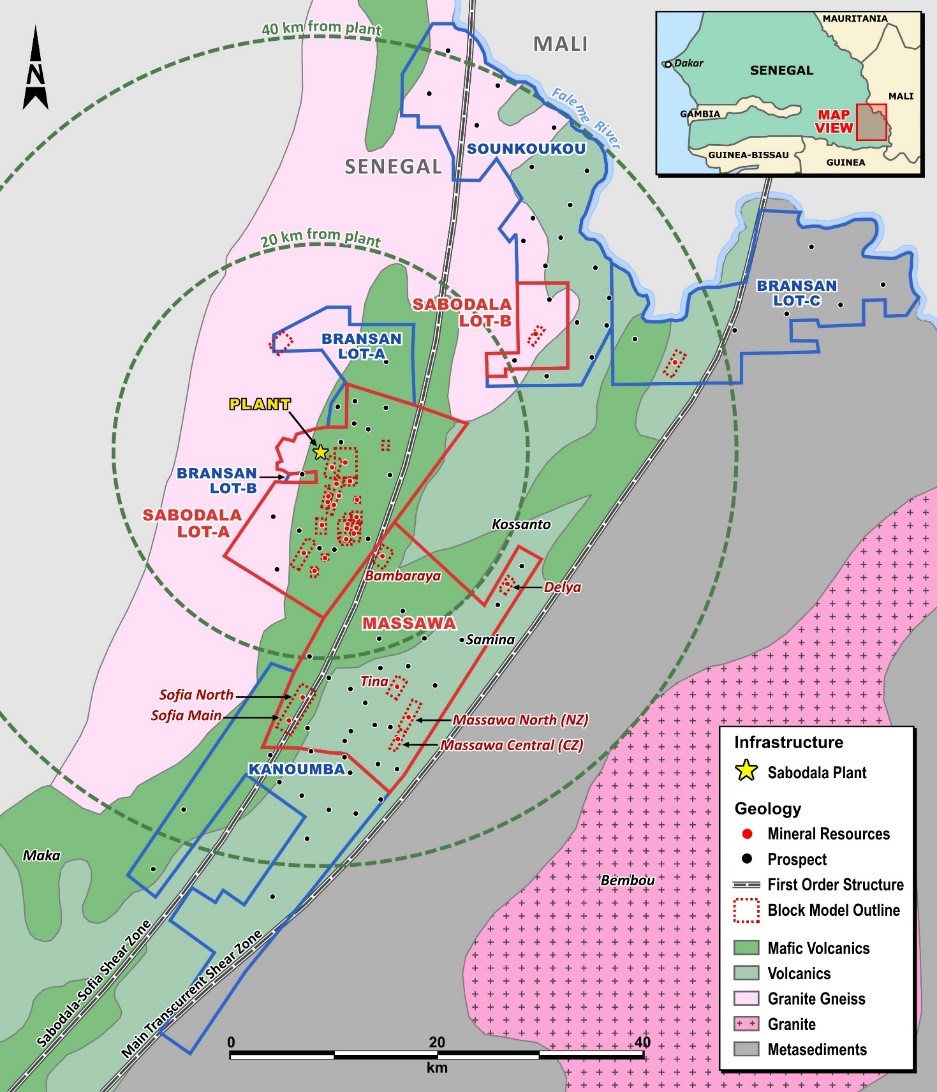Endeavour Increases 2021 Production Guidance by 50% to 1.4 - 1.5 Million Ounces
Endeavour Mining has raised its 2021 production guidance by 50% to between 1.4 and 1.5 million ounces, following the integration of the Sabodala-Massawa and Wahgnion mines. The all-in sustaining cost (AISC) guidance has decreased to $840 - $890 per ounce, down by $40. The exploration budget is also increased by 40% to between $70 to $90 million, focusing on new and existing assets. The Phase 1 expansion of the Sabodala-Massawa mine is expected to complete by year-end, with a Definitive Feasibility Study for Phase 2 also underway.
- Production guidance increased by 50% to 1.4 - 1.5 million ounces.
- AISC guidance reduced by $40 to $840 - $890 per ounce.
- Exploration budget increased by 40% to $70 - $90 million.
- Phase 1 expansion at Sabodala-Massawa expected completion by year-end.
- Potential for share buybacks or increased dividends highlighted.
- None.
Insights
Analyzing...
ENDEAVOUR INCREASES 2021 PRODUCTION GUIDANCE BY
Sabodala-Massawa expansion underway AISC guidance reduced by
HIGHLIGHTS
- 2021 guidance has been updated to reflect the newly integrated Sabodala-Massawa and Wahgnion mines:
- Production guidance for continuing operations increased by
50% to 1.4 - 1.5Moz - AISC guidance for continuing operations decreased by
$40 /oz to$840 - 890/oz
- Production guidance for continuing operations increased by
- 2021 exploration budget increased by
40% to$70 -$90m with strong focus on newly acquired assets and greenfield properties - Construction for Sabodala-Massawa Phase 1 expansion expected to be completed by year-end; DFS for Phase 2 expansion expected by year-end
George Town, February 25, 2021 – Endeavour Mining (TSX:EDV) (OTCQX:EDVMF) is pleased to announce that it has increased its guidance for 2021 to include production from the recently integrated Sabodala-Massawa and Wahgnion mines, following completion of the Teranga Gold Corporation (“Teranga”) acquisition.
As shown in Table 1 below, consolidated 2021 production guidance for continuing operations has increased from 900,000 – 990,000 ounces to 1,350,000 – 1,475,000 ounces, while consolidated AISC guidance has decreased by
Table 1: Consolidated Production Guidance for Continuing Operations
| PREVIOUS GUIDANCE | UPDATED GUIDANCE | VARIANCE | |||||||
| Gold Production, koz | 900 | - | 990 | 1,350 | - | 1,475 | +450 | - | +485 |
| AISC, $/oz | 880 | - | 930 | 840 | - | 890 | (40) | - | (40) |
In addition, Endeavour is progressing with the two-phase expansion project at the Sabodala-Massawa mine to unlock the value of the Massawa deposits. The first phase, which is expected to increase production by approximately 90kozpa, has commenced and is expected to be completed by year-end. Following the positive outcome of the 2020 Pre-Feasibility Study (“PFS”) for the second phase, which outlined the potential to increase production to above 400koz per year1, a Definitive Feasibility Study (“DFS”) is underway and is expected to be completed by year-end. Further details for each phase are outlined below.
Sébastien de Montessus, President & CEO, commented: “Today’s updated 2021 guidance confirms our position as a senior, low cost, global gold producer and re-affirms our confidence in the potential of the newly acquired mines.
The integration of the Sabodala-Massawa and Wahgnion mines is progressing well as we remain focused on optimizing operations and delivering on the anticipated synergies. We are therefore moving forward with the Phase 1 expansion at the Sabodola-Massawa mine, which is the first stage in unlocking value from the large, high grade Massawa deposits, and in parallel we are advancing the DFS on Phase 2 and ramping-up exploration.
Given the significant potential within our portfolio, our sole strategic priority is to unlock value organically through mine life extensions, asset optimization initiatives, and by advancing our brownfield and greenfield projects through studies and further exploration. As such, investment in exploration remains a core focus and consequently we have increased our 2021 budget to
Our corporate efforts continue to be focused on maximizing shareholder returns, with the goal of augmenting our shareholder return program, which may include increasing our dividend or initiating a share buyback program as part of our capital allocation framework. In addition, we are on track to obtain a listing on the Premium segment of the London Stock Exchange in late Q2-2021, which we believe will boost investor appeal.”
ABOUT THE SABODALA-MASSAWA MINE
2021 Outlook
From the date of Sabodala-Massawa’s acquisition by Endeavour, which closed on February 10, 2021, the mine is expected to produce between 300-320koz at an AISC of
Ore mined is expected to be higher than in 2020 due to increased availability of the mobile equipment fleet for mining in 2021, as compared to 2020, when a portion of the fleet was used for the construction of the Massawa haul road. The two Sofia pits, Sofia Main and Sofia North, on the Massawa mining permit will contribute close to
Plant throughput and recovery rates are expected to decrease slightly from the 4.1Mt and
Sustaining capital expenditures are expected to amount to
Sabodala-Massawa Expansion Phase 1
The Massawa deposit is being integrated into the Sabodala mine through a two-phased approach, as outlined in the 2020 PFS. Phase 1 of the expansion will facilitate processing of an increased proportion of high grade, free-milling Massawa ore through the Sabodala processing plant, which will avoid bottlenecks and prevent gold loss to tailings. The addition of the Massawa ore will increase the average processing head grade from 1.5 g/t, up to a peak head grade of 2.8 g/t, while maintaining milling capacity at the current 4.0 – 4.2Mtpa level. The plant upgrades are expected to increase the Sabodala-Massawa gold production by up to 90kozpa2.
As shown in Figure 1 below, Phase 1 will increase the Sabodala plant’s overall gold production capacity through additions to the gold separation, concentration, elution and electrowinning facilities at the back-end of the plant. The detailed engineering for Phase 1 was completed by Lycopodium Limited. Procurement is largely complete with some packages already delivered, and the civil engineering contractor is currently mobilizing to site.
Figure 1: Upgraded Sabodala-Massawa Processing Plant Layout
As shown in Figure 1, the upgrades are focused on six key areas as detailed below:
- An additional electrowinning cell will be added to the gold room to increase its capacity to process high grade ore
- An additional carbon regeneration kiln will be added to increase carbon regeneration capacity
- An additional acid wash and elution circuit will be added to increase the total average capacity from 5 to 13 tonnes per day
- One additional leach tank will be added, increasing the leaching and CIL residence time from 24 to 32 hours, which is expected to improve the recoveries from Massawa ore
- One existing leach tank will be converted to a CIL tank to increase capacity
- A gravity circuit, consisting of a gravity feed scalping screen and a gravity concentrator will be added to reduce the load on the downstream circuit. The gravity circuit will process the coarse free-milling ore through the intensive leach circuit.
Completion of Phase 1 is expected in Q4-2021, as detailed in Figure 2 below.
Figure 2: Phase 1 timeline
Sabodala-Massawa Expansion Phase 2
Phase 2 of the expansion will add an additional processing circuit to process the high grade refractory ore from the Massawa deposit, through the addition of a new refractory ore plant. A DFS for Phase 2 is underway and due for completion in Q4-2021, focusing on the following optimizations:
- Improved geometallurgical modelling incorporating a wider range of elements into the resource block model, to improve the quality of the mill feed blend resulting in improved plant efficiencies and recoveries
- Pit optimization to redefine the boundary between refractory ore and non-refractory ore to minimize losses due to dilution
- Processing optimization testwork to investigate operating cost and recovery improvements
- Metallurgical optimization testwork focused on comminution and variability, leaching and flotation
Figure 3: Proposed Sabodala-Massawa Phase 2 PFS Plant Layout
Exploration upside
Significant exploration potential exists within 30km of the processing facility, which includes the Sabodala mining license, the Massawa mining license, and additional exploration permits which respectively cover 291km2, 320km2 and 915km2, as shown in Figure 4 below.
Over 36,000 metres were drilled in 2020 with activity planned to ramp up significantly in 2021, specifically on the Massawa deposits, with a budget of
During 2021, drilling will be concentrated on the Sofia deposit and the satellite deposits Samina, Tina and Delya. At Sofia North, drilling will be directed towards extending the non-refractory ore resources. Samina, Tina and Delya have had limited shallow drilling to date and show potential for additional mineralization at depth. Initial drill results at Samina demonstrate possible oxide mineralization at depth, which will be tested during 2021. Tina is a target where some reconnaissance drilling has been conducted.
A number of other prospects, located within the structural corridor between the Sabodala Sofia Shear Zone and the Main Transcurrent Shear Zone, will also be explored.
Figure 4: Sabodala-Massawa Plan Map
ABOUT THE WAHGNION MINE
2021 Outlook
From the date of Wahgnion’s acquisition by Endeavour, which closed on February 10, 2021, the mine is expected to produce between 140 - 155koz at an AISC of
In 2021, total tonnes mined will remain in line with the strong performance seen in 2020, as the supplemental mining contractors will be retained to meet the continued above nameplate throughput. Mining activity is expected to focus on the Nogbele North and South pits, supplemented with ore from the Fourkoura pits, which commenced mining operations at the start of 2021.
Plant throughput and gold recovery rate are expected to decrease slightly in 2021, compared to the 3.6Mt and
Sustaining capital of
Exploration upside
Given the recent commissioning of the Wahgnion mine in late 2019, significant exploration potential exists within the permitted mine license and five surrounding exploration permits, which respectively cover an area of 89km2 and
920km2, as shown in Figure 5 below.
The 2021 exploration program, with a budget of
Figure 5: Map of Wahgnion Mine and Permit Area
UPDATED 2021 OUTLOOK
As shown in Tables 2 and 3 below, consolidated total production guidance for 2021 has increased from 915,000 – 1,010,000 ounces to 1,365,000 – 1,495,000 ounces, while consolidated AISC guidance has decreased by
Consolidated production from continuing operations, which excludes Agbaou following its sale, is expected to be between 1,350,000 – 1,475,000 ounces at AISC of
Table 2: 2021 Consolidated Production Guidance
| (All amounts in koz, on a | PREVIOUS GUIDANCE | UPDATED GUIDANCE | ||||
| Ity | 230 | — | 250 | 230 | — | 250 |
| Karma | 80 | — | 90 | 80 | — | 90 |
| Houndé | 240 | — | 260 | 240 | — | 260 |
| Mana | 170 | — | 190 | 170 | — | 190 |
| Boungou | 180 | — | 200 | 180 | — | 200 |
| Sabodala-Massawa | n.a. | — | n.a. | 310 | — | 330 |
{
"@context": "https://schema.org",
"@type": "FAQPage",
"name": "Endeavour Increases 2021 Production Guidance by 50% to 1.4 - 1.5 Million Ounces FAQs",
"mainEntity": [
{
"@type": "Question",
"name": "What is Endeavour Mining's new production guidance for 2021?",
"acceptedAnswer": {
"@type": "Answer",
"text": "Endeavour Mining has increased its production guidance for 2021 to between 1.4 and 1.5 million ounces."
}
},
{
"@type": "Question",
"name": "How much has AISC guidance changed for Endeavour Mining in 2021?",
"acceptedAnswer": {
"@type": "Answer",
"text": "The AISC guidance has decreased by $40 to a range of $840 - $890 per ounce."
}
},
{
"@type": "Question",
"name": "What is the exploration budget for Endeavour Mining in 2021?",
"acceptedAnswer": {
"@type": "Answer",
"text": "Endeavour Mining's exploration budget for 2021 has been increased by 40% to between $70 and $90 million."
}
},
{
"@type": "Question",
"name": "When is the Phase 1 expansion of the Sabodala-Massawa mine expected to be completed?",
"acceptedAnswer": {
"@type": "Answer",
"text": "The Phase 1 expansion of the Sabodala-Massawa mine is expected to be completed by the end of the year."
}
},
{
"@type": "Question",
"name": "What are Endeavour Mining's plans regarding shareholder returns in 2021?",
"acceptedAnswer": {
"@type": "Answer",
"text": "Endeavour Mining aims to augment shareholder returns, potentially increasing dividends or initiating a share buyback program."
}
}
]
}
FAQWhat is Endeavour Mining's new production guidance for 2021?
Endeavour Mining has increased its production guidance for 2021 to between 1.4 and 1.5 million ounces.
How much has AISC guidance changed for Endeavour Mining in 2021?
The AISC guidance has decreased by $40 to a range of $840 - $890 per ounce.
What is the exploration budget for Endeavour Mining in 2021?
Endeavour Mining's exploration budget for 2021 has been increased by 40% to between $70 and $90 million.
When is the Phase 1 expansion of the Sabodala-Massawa mine expected to be completed?
The Phase 1 expansion of the Sabodala-Massawa mine is expected to be completed by the end of the year.
What are Endeavour Mining's plans regarding shareholder returns in 2021?
Endeavour Mining aims to augment shareholder returns, potentially increasing dividends or initiating a share buyback program.
Endeavour Mining
OTC:EDVMFEDVMF RankingsEDVMF Latest NewsOct 31, 2025
Transaction in Own Shares
Oct 29, 2025
Transaction in Own Shares
Oct 29, 2025
Endeavour Announces Holdings(s) in Company
Oct 22, 2025
Transaction in Own Shares
EDVMF Stock Data | ||||||













